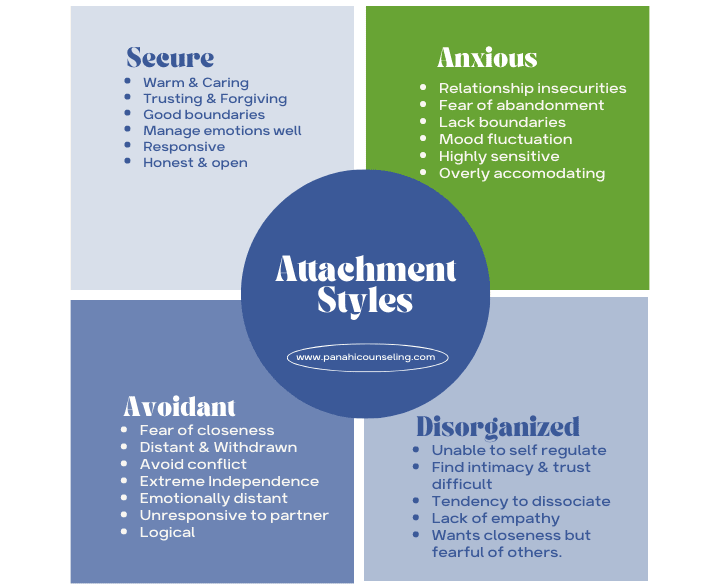Your Attachment Style Is Showing

Why do some couples seem to connect effortlessly while others struggle with misunderstanding and mistrust? The answer often lies in attachment theory, a psychological framework that explains how early experiences with caregivers shape our expectations and behaviors in adult relationships. Understanding attachment styles not only helps individuals identify patterns in their own behavior but can significantly improve the quality and depth of romantic connections.
What Are Attachment Styles?
Attachment theory, developed by psychologist John Bowlby and expanded by Mary Ainsworth, identifies four main attachment styles: secure, anxious, avoidant, and fearful-avoidant (also known as disorganized). Each style stems from the level of safety and responsiveness a person experienced in early childhood relationships.
- Avoidant attachment: People with avoidant tendencies value independence to the point of emotional distance. They may struggle with vulnerability or expressing emotions.
- Fearful-avoidant attachment: A mix of anxious and avoidant traits, these individuals want intimacy but fear getting hurt.
These styles influence how people behave in romantic relationships, how they communicate, resolve conflict, and express love or concern.
How Attachment Plays Out in Relationships
In a relationship, each partner’s attachment style affects the emotional dynamic. For instance, an anxious person might frequently seek reassurance, which can overwhelm an avoidant partner who prefers space. This dynamic, known as the “anxious-avoidant trap,” is one of the most common sources of recurring conflict in relationships.
They are generally more empathetic, responsive, and open to emotional intimacy. As a result, they can often help a less secure partner feel more at ease and encourage healthier relational patterns over time.
However, mismatches in attachment can create friction if not addressed. An avoidant partner may interpret emotional closeness as a threat to their autonomy, while an anxious partner may view emotional distance as a rejection. Without awareness of these patterns, couples may find themselves stuck in cycles of miscommunication.
Changing Your Attachment Style
With intentional effort, therapy, and the presence of a supportive partner, individuals can develop more secure attachments. This process, sometimes called “earned security,” involves recognizing personal triggers and behavioral patterns, practicing emotional regulation techniques, engaging in open, non-defensive communication, and creating consistent, safe experiences within the relationship are all essential steps toward developing secure attachment.
According to a study published by the National Institutes of Health (NIH), couples who actively work to understand and support each other’s emotional needs report higher relationship satisfaction and lower levels of distress, regardless of their initial attachment style.
Therapists often recommend journaling, mindfulness practices, or emotionally focused therapy (EFT) to help individuals and couples shift toward secure attachment. Over time, repeated experiences of trust, empathy, and mutual respect can reshape even long-held patterns.
Attachment and Conflict Resolution
Attachment styles can also influence how couples handle conflict. Anxious individuals may escalate arguments quickly due to fear of losing their partner, while avoidant individuals may shut down or withdraw. Secure partners, on the other hand, tend to approach conflict with a problem-solving mindset rather than a defensive one.
Understanding each other’s attachment patterns can help couples approach disagreements with more compassion. For example, if a partner knows their spouse has anxious tendencies, they might take extra care to offer reassurance rather than criticism during a disagreement. Conversely, knowing that a partner has avoidant traits might encourage someone to give space rather than push for immediate emotional processing.
Where Prenups Fit In
While attachment theory mainly focuses on emotional dynamics, it can also have practical implications. For instance, discussing financial matters like prenuptial agreements can be particularly challenging for couples with insecure attachment styles. An anxious partner might interpret a prenup as a sign of impending abandonment, while an avoidant partner might use it to create emotional distance.
However, in securely attached relationships, a prenup can be viewed as a thoughtful, pragmatic discussion, a way to ensure clarity and fairness in the future. When couples approach the subject with emotional security and transparency, it often fosters deeper trust.
In fact, introducing topics like prenuptial agreements early on, in a safe and supportive environment, can be an exercise in building emotional intimacy. When both partners feel heard and respected, even sensitive topics become opportunities for connection rather than division. More couples are turning to resources like marriagescience.com to navigate such conversations with empathy and insight.
Final Thoughts
Understanding attachment styles can be a game-changer for romantic relationships. Whether you’re dating, engaged, or married, identifying and working with your own and your partner’s attachment style leads to healthier communication, stronger emotional bonds, and greater relationship satisfaction.
While love may start with chemistry, lasting connection is built through emotional safety, trust, and intentional effort. And yes sometimes even a prenup can be part of that emotional growth.
By bringing awareness to these deeply rooted patterns and seeking out trustworthy, research-based guidance from sources like the American Psychological Association couples can transform old habits and build a partnership that truly lasts.





